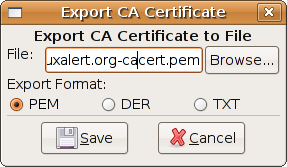Create your own CA with TinyCA2 (part 3)
In this final part we will add our own root CA certificate to Ubuntus pre-installed certificates. (Part 1 , Part 2 ) Copy your root CA certificate, that we exported in the previous part, to /usr/share/ca-certificates/. Add the file name to /etc/ca-certificates.conf and run the command: sudo update-ca-certificates Most of your services will now be able to find your root CA certificate. To bring your root CA certificate to your friends, just copy the exported root certificate-file to a USB-memory. Using your own CA you can now add support SSL to different services like CUPS, postfix(AUTH SMTP), dovecot (IMAP) etc. You can also create certificates to sign and encrypt your e-mails.

